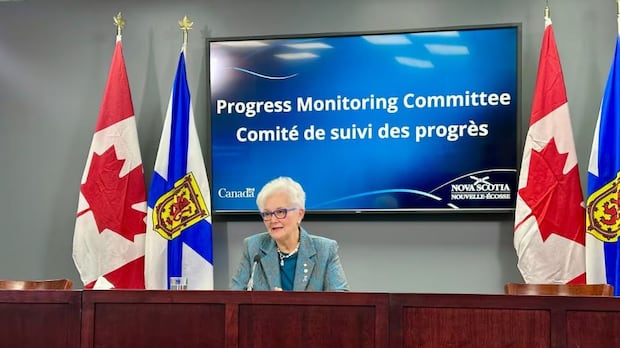For the first time, N.S. communities have assessments on local housing needs

Bridgewater Mayor David Mitchell says his town has been working hard over many years to collect information on housing.
So it wasn’t a shock when he learned the South Shore town had a shortage of 245 homes, as of the end of 2022.
“It’s a lot of people who are looking to live in our community that will have to wait,” he told CBC in a recent interview.
Bridgewater is just one of many Nova Scotian municipalities facing a gap of hundreds — and in some cases, thousands — of new housing units.
That information was revealed this fall in housing assessments paid for by the province and completed by an independent consulting company. It’s the first time many towns have ever had access to this type of information, and the first time it’s been standardized across the province.
“I think it’s important,” Mitchell said of the assessments. “I think standardizing it is good, too, because it helps us all have these conversations together as municipalities.”
Bridgewater’s assessment says the gap in housing supply could be addressed by 2032, and Mitchell hopes to do it sooner. But that will depend on developers.
“What we’ve seen a lot of right now are developers saying, ‘OK, we still want to do our project … but right now we can’t because borrowing costs are too high,'” he said.
Outside of Halifax, the municipalities with the biggest housing gaps at the end of 2022 were the County of Annapolis (1,015 units) and Cape Breton Regional Municipality (1,000 units).
By 2027, those gaps could widen to include municipalities like Wolfville (705 units) and the district of Digby (800 units).
Years of population declines
Of more than 40 housing assessments CBC examined, seven said the municipalities don’t have a shortage of housing right now, or the shortage was “marginal.” Some of these towns had shrinking populations, such as Berwick, Clark’s Harbour, Digby, Stellarton, and Pictou.
Between 2016 and 2021 the Pictou population decreased by three per cent.
“That was one of the challenges when I was first elected as mayor seven years ago,” Jim Ryan said.
But in the last few years he’s seen more young families moving to Pictou, with some coming from as far away as B.C. or Ontario during the pandemic. He says the closure of the Northern Pulp mill in early 2020 made the town more attractive by removing the smell in the air, and the expansion of the deCoste Centre cultural hub is expected to boost the arts community.
“It was almost overnight that we saw housing prices almost double here,” he said.
The report said Pictou saw a 94 per cent increase in the median home price over three years, and local businesses reported trouble keeping staff due to a lack of affordable housing.
However, the report said due to the population decline there is “no anticipated demand for housing in the near term,” adding there might even be a “surplus by 2023.”
Ryan was surprised by that, as he said the cost of new rentals coming on the market can be as high as $2,000 per month. The town has heard of local landlords reporting few or no vacancies in their rental properties, and having to keep waiting lists for prospective tenants.
The consulting company that authored the report was Turner Drake and Partners. Neil Lovitt, vice-president of the company’s planning division, explained more about Pictou’s situation in an email to CBC News.
“There can certainly be trends and experiences on the ground that are worthy of attention, but are not significant enough yet to show up in the gap analysis given the method it uses,” he wrote.
Pictou’s historical decreasing population makes any gap in housing less obvious in the analysis. As well, the reports used data from the 2021 census and property records, which may not reflect new developments yet because the analysis was done close to the “turning point” when things started to change.

Ryan says the town has granted permits to a number of different construction projects, which total 40 units. It expects to grant more soon. The town applied for money under the federal Housing Accelerator Fund to get help with infrastructure. As part of its application the town included the housing assessment.
“How much will it affect our chances if a provincial assessment says you don’t need housing in Pictou?” Ryan says. “It has the potential to have an effect. But people want to come to Pictou.”
Rapid growth
Meanwhile, the town of Stewiacke is undergoing what Greg Brown calls a “construction boom.” Brown was working as the CAO when he spoke with CBC but has since resigned.
Between 2016 and 2021 it had a 14 per cent increase in population — one of the highest jumps in the province.
“Our challenge has really been more to keep pace with what’s happening than to be concerned about the lack of development,” Brown told CBC.
The report identified a gap of 50 units, and Brown was surprised the town’s assessment suggested five new units could be completed annually.
In the last three years the town has approved 74 new single-family homes, most of which are “either underway or built.” There are also nine different apartment projects approved totalling 86 units. Brown estimates up to 42 units could come on stream next year.
“It’s a little different than five per year. But that’s what’s making Stewiacke the exception,” he said.
He attributes it to Stewiacke being just under an hour’s drive to Halifax on Highway 102.
“I think people have been commuting for many years, and it’s just now becoming more of an option in light of the high costs of living in the city,” he said.
The town has long thought it would have development opportunities because of its location, Brown said.
“The demand is finally picking up to the point where it’s starting to occur,” he said. “It’s a good problem to have.”
Check out your municipality
There are 49 municipalities in Nova Scotia, each with its own housing needs assessment. Click on your municipality below to find some basic statistics from the report, along with a link to the full report.
A few municipalities did not respond to CBC’s request to share the assessment, or were delayed in supplying their assessments. These will be added to the map as they become available.





